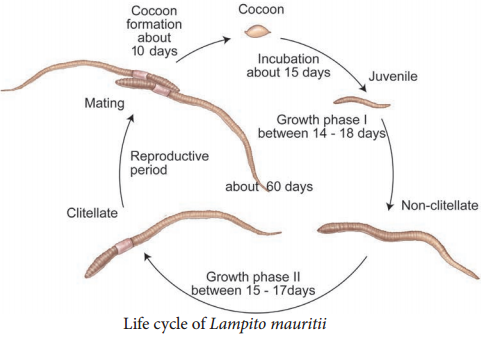Learninsta presents the core concepts of Biology with high-quality research papers and topical review articles.
Earthworm – Lampito Mauritii
Earthworm is a terrestrial invertebrate that inhabits the upper layers of the moist soil, rich in decaying organic matter. It is nocturnal and during the day it lives in burrows made by burrowing and swallowing the soil. In gardens, they can be traced by their faecal deposits known as worm castings on the soil surface.
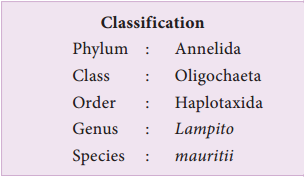
Earthworms are considered as “Friends of Farmers”. The common Indian earthworms are Lampito mauritii (Syn. Megascolex mauritii), Perioynx excavatus and Metaphire posthuma (Syn. Pheretima posthuma). Earthworms are also conveniently classified based on their ecological strategies as epigeics, anecics and endogeics (Figure 4.1).
Epigeics (Greek for “up on the earth”) are surface dwellers, eg. Perionyx excavatus and Eudrilus eugeniae. Anecics (Greek for “outer layer of the earth”) are found in upper layers of the soil, eg. Lampito mauritii, Lumbricus terrestris. Endogeics (Greek for “within the earth”) are found in deeper layers of the soil eg. Octochaetona thurstoni.
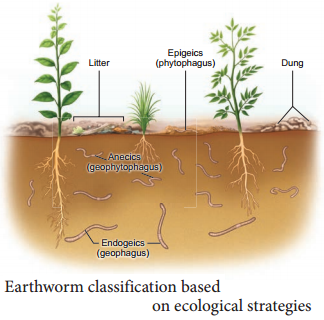
Morphology
Lampito mauritii is commonly found in Tamil Nadu. It has a long and cylindrical narrow body which is bilaterally symmetrical. L. mauritii is 80 to 210 mm in length with a diameter of 3.5 – 5 mm, and is light brown in colour, with purplish tinge at the anterior end. This colour of the earthworm is mainly due to the presence of porphyrin pigment.
The body of the earthworm is encircled by a large number of grooves which divides it into a number of compartments called segments or metameres (Figure 4.2). L. mauritii consists of about 165 – 190 segments. The dorsal surface of the body is marked by a dark mid dorsal line (dorsal blood vessel) along the longitudinal axis of the body.
The ventral surface is distinguished by the presence of genital openings. The mouth is found in the centre of the first segment of the body, called the peristomium. Overhanging the mouth is a small flap called the upper lip or prostomium. The last segment has the anus called the pygidium. In mature worms, segments 14 to 17 may be found swollen with a glandular thickening of the skin called the clitellum. This helps in the formation of the cocoon.
Due to the presence of clitellum, the body of an earthworm is divided into pre clitellar region (1st – 13th segments), clitellar region (14th – 17th segments) and the post – clitellar region (after the 17th segment). In all the segments of the body except the first, last and clitellum, there is a ring of chitinous body setae. This body setae arises from a setigerous sac of the skin and it is curved as S – shaped. Setae can be protruded or retracted and their principal role is in locomotion.
The external apertures are the mouth, anus, dorsal pores, spermathecal openings, genital openings and nephridiopores. The dorsal pores are present from the 10th segment onwards. The coelomic fluid communicates to the exterior through these pores and keeps the body surface moist and free from harmful microorganisms.
Spermathecal openings are three pairs of small ventrolateral apertures lying intersegmentally between the grooves of the segments 6/7, 7/8 and 8/9. A pair of female genital apertures lie on the ventral side in the 14th segment and a pair of male genital apertures are situated latero-ventrally in the 18th segment. Nephridiopores are numerous and found throughout the body of the earthworm except a few anterior segments, through which the metabolic wastes are eliminated.
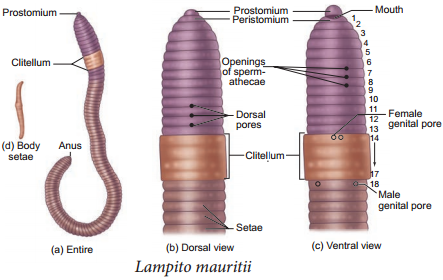
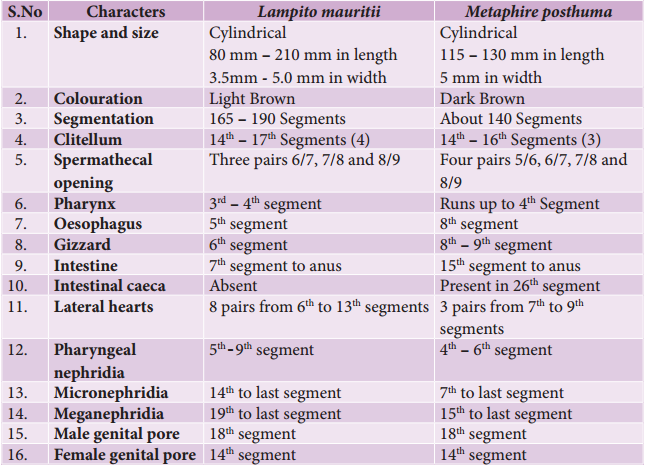
Anatomy
The body wall of the earthworm is very moist, thin, soft, skinny, elastic and consists of the cuticle, epidermis, muscles and coelomic epithelium. The epidermis consists of supporting cells, gland cells, basal cells and sensory cells.
A spacious body cavity called the coelom is seen between the alimentary canal and the body wall. The coelom contains the coelomic fluid and serves as a hydrostatic skeleton, in which the coelomocytes are known to play a major role in regeneration, immunity and wound healing. The coelomic fluid of the earthworm is milky and alkaline, which consists of granulocytes or eleocytes, amoebocytes, mucocytes and leucocytes.
Digestive System
The digestive system of the earthworm consists of the alimentary canal and the digestive glands. The alimentary canal runs as a straight tube throughout the length of the body from the mouth to anus (Figure 4.3).
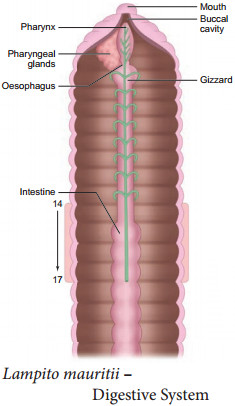
The mouth opens into the buccal cavity which occupies the 1st and 22nd segments. The buccal cavity leads
into a thick muscular pharynx, which occupies the 3rd and 4th segments and is surrounded by the pharyngeal glands. A small narrow tube, oesophagus lies in the 5th segment and continues into a muscular gizzard in the 6th segment.
The gizzard helps in the grinding of soil particles and decaying leaves. Intestine starts from the 7th segment and continues till the last segment. The dorsal wall of the intestine is folded into the cavity as the typhlosole. This fold contains blood vessels and increases the absorptive area of the intestine. The inner epithelium consists of columnar cells and glandular cells. The alimentary canal opens to the exterior through the anus.
The ingested organic rich soil passes through the digestive tract where digestive enzymes breakdown complex food into smaller absorbable units. The simpler molecules are absorbed through the intestinal membrane and are utilized.
The undigested particles along with earth are passed out through the anus, as worm castings or vermicasts. The pharyngeal or salivary gland cells and the glandular cells of the intestine are supposed to be the digestive glands which secrete digestive enzymes for digestion of food.
Respiratory System
The earthworm has no special respiratory organs like lungs or gills. Respiration takes place through the body wall. The outer surface of the skin is richly supplied with blood capillaries which aid in the diffusion of gases. Oxygen diffuses through the skin into the blood while carbon dioxide from the blood diffuses out. The skin is kept moist by mucous and coelomic fluid and facilitates exchange of gases.
Circulatory System
Lampito mauritii exhibits a closed type of blood vascular system consisting of blood vessels, capillaries and lateral hearts (Figure 4.4). Two median longitudinal vessels run above and below the alimentary canal as dorsal and ventral vessels of the earthworm. There are paired valves in the dorsal vessels which prevent the backward flow of the blood.
The ventral vessel has no valves and is non contractile, allowing the backward flow of blood. In the anterior part of the body the dorsal vessel is connected with the ventral vessel by eight pairs of commissural vessels or the lateral hearts lying in the 6th to 13th segments. These vessels run on either side of the alimentary canal and pump blood from the dorsal vessel to the ventral vessel.
The dorsal vessel receives blood from various organs in the body. The ventral vessel supplies blood to the various organs. Blood glands are present in the anterior segments of the earthworm. They produce blood cells and haemoglobin which is dissolved in the plasma and gives red colour to the blood.

Nervous System
The bilobed mass of nervous tissue called supra – pharyngeal ganglia, lies on the dorsal wall of the pharynx in the 3rd segment, is referred as the “brain”. The ganglion found below the pharynx in the 4th segment is called the sub-pharyngeal ganglion (Figure. 4.4). The brain and the sub – pharyngeal ganglia are connected by a pair of circum-pharyngeal connectives.
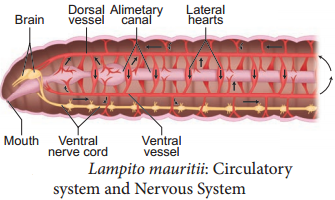
They run one on each side of the pharynx. Thus a nerve ring is formed around the anterior region of the alimentary canal. The double ventral nerve cord runs backward from the sub – pharyngeal ganglion. The brain along with other nerves in the ring integrates sensory inputs and command muscular responses of the body.
The earthworm’s receptors are stimulated by a group of slender columnar cells connected with nerves. The Photoreceptors (sense of light) are found on the dorsal surface of the body. Gustatory (sense of taste) and oldfactory receptors (sense of smell) are found in the buccal cavity. Tactile receptors (sense of touch), chemoreceptors (detect chemical changes) and thermoreceptors (changes in temperature) are present in
the prostomium and the body wall.
Excretory System
Excretion is the process of elimination of metabolic waste products from the body. In earthworm, excretion is effected by segmentally arranged, minute coiled, paired tubules called nephridia. There are three types of nephridia; (i) pharyngeal or tufted nephridia – present as paired tufts in the 5th – 9th segments (ii) Micronephridia or Integumentary nephridia – attached to the lining of the body wall from the 14th segment to the last which open on the body surface (iii) Meganephridia or septal nephridia – present as pair on both sides of intersegmental septa of the 19th segment to the last and open into intestine (Figure 4.5).
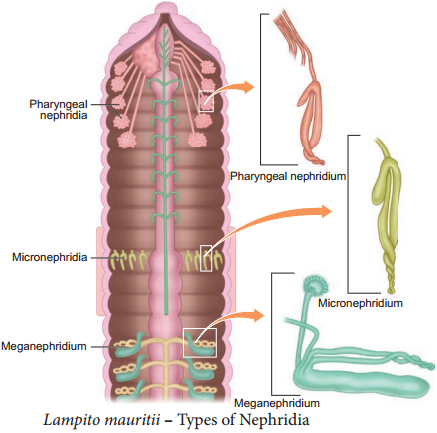
The meganephridium has an internal funnel like opening called the nephrostome, which is fully ciliated. The nephrostome is in the preceding segment and the rest of the tube is in the succeeding segment. This tube consists of three distinct divisions, the ciliated, the glandular and the muscular region.
The waste material collected through the ciliated funnel is pushed into the muscular part of nephridium by the ciliated region. The glandular part extracts the waste from the blood and finally the wastes exit out through the nephridiopore.
Besides nephridia, special cells on the coelomic wall of the intestine, called chloragogen cells are present. They extract the nitrogenous waste from the blood of the intestinal wall, into the body cavity to be sent out through the nephridia.
Reproductive System
Earthworms are hermaphrodites or monoecious i.e. male and female reproductive organs are found in the same individual (Figure 4.6). Self fertilization is avoided because two sex organs mature at different times, which means the sperm develops earlier than the production of ova (Protandrous). Thus cross fertilization takes place.
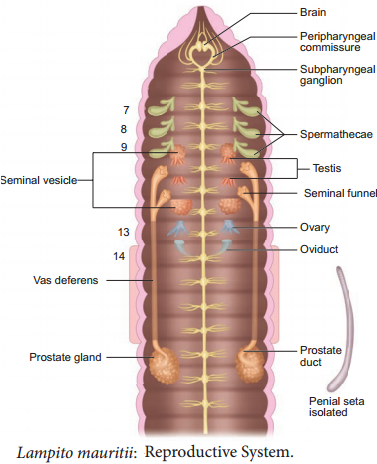
In the male reproductive system, two pairs of testes are present in the 10th and 11th segments. The testes
give rise to the germ cells or spermatogonia, which develops into spermatozoa in the two pairs of seminal vesicles. Two pairs of seminal funnels called ciliary rosettes are situated in the same segments as the testes.
The ciliated funnels of the same side are connected to a long tube called vas deferens. The vasa deferentia run upto the 18th segment where they open to the exterior through the male genital aperture. The male genital aperture contains two pairs of penial setae for copulation. A pair of prostate glands lies in the 18th – 19th segments. The secretion of the prostate gland serves to cement the spermatozoa into bundles known as spermatophores.
The female reproductive system consists of a pair of ovaries lying in the 13th segment. Each ovary has finger like projections which contain ova in linear series. Ovarian funnels are present beneath the ovaries which continue into the oviducts.
They open as a pair of genital apertures on the ventral side of the 14th segment. Spermathecae or seminal receptacles are three pairs lying in segments 7th, 8th and 9th, opening to the exterior on the ventral side between 6th & 7th, 7th & 8th and 8th & 9th segments. They receive spermatozoa from the partner and store during copulation.
A mutual exchange of sperms occurs between two worms during mating. One worm has to find another worm and they mate juxtaposing opposite gonadal openings, exchanging the sperms. Mature egg cells in the nutritive fluid are deposited in the cocoons produced by the gland cells of the clitellum which also collects the partner’s sperms from the spermthecae. Fertilization and development occurs within the cocoons, which are deposited in the soil. After about 2 – 3 weeks, each cocoon produces baby earthworms. Development is direct and no larva is formed during development.
Life Cycle
Lampito mauritii begins its life cycle, from the fertilized eggs. The eggs are held in a protective cocoon. These cocoons have an incubation period of about 14 – 18 days after which they hatch to release juveniles (Figure 4.7).
The juveniles undergo changes into non-clitellate forms in phase – I after about 15 days, which then develops a clitellum, called the clitellate at the end of the growth phase – II taking 15 – 17 days to complete. During the reproductive stage, earthworms copulate, and later shed their cocoons in the soil after about 10 days. The life cycle of Lampito mauritii takes about 60 days to complete.
